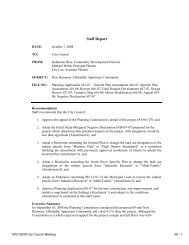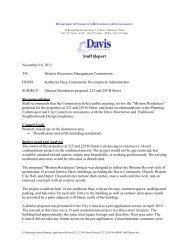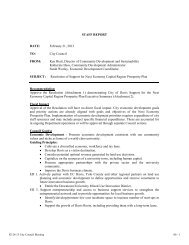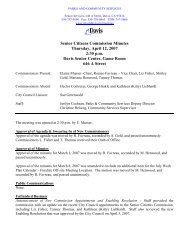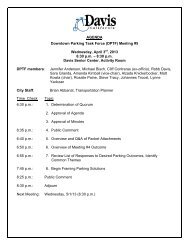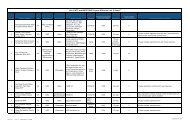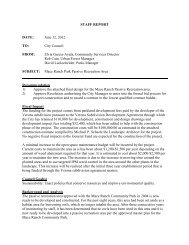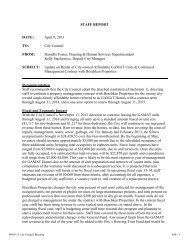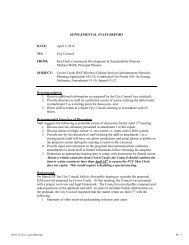10 Draft Integrated Waste Management Plan - City Council - City of ...
10 Draft Integrated Waste Management Plan - City Council - City of ...
10 Draft Integrated Waste Management Plan - City Council - City of ...
You also want an ePaper? Increase the reach of your titles
YUMPU automatically turns print PDFs into web optimized ePapers that Google loves.
2012 Davis <strong>Integrated</strong> <strong>Waste</strong> <strong>Management</strong> <strong>Plan</strong><br />
It is <strong>of</strong>ten requested that the <strong>City</strong>’s diversion or per capita disposal rate be compared to other local agencies. The<br />
charts and tables presented in Appendix K <strong>of</strong>fer such a comparison. However, it must be noted that CalRecycle<br />
itself strictly advises against such comparisons:<br />
Advisory! The per capita disposal rate is a jurisdiction-specific index and cannot be compared between<br />
jurisdictions. The per capita disposal rate is used as one <strong>of</strong> several "factors" in determining a<br />
jurisdiction's compliance with the intent <strong>of</strong> AB 939, and allows the California Department <strong>of</strong> Resources<br />
Recycling and Recovery (CalRecycle) and jurisdictions to set their primary focus on successful<br />
implementation <strong>of</strong> diversion programs. Meeting the disposal rate targets is not necessarily an indication<br />
<strong>of</strong> compliance.<br />
http://www.calrecycle.ca.gov/LGCentral/reports/diversionprogram/JurisdictionDiversionPost2006.aspx<br />
Unfortunately, this warning is rarely heeded and comparisons between other jurisdictions are frequently<br />
performed regardless. If a comparison must be done, the best way to compare one jurisdiction to another is to<br />
look at the waste generation. The tables and figures in Appendix K compare the residential and employee waste<br />
generation per capita numbers <strong>of</strong> several jurisdictions.<br />
The State <strong>of</strong> California took another step to increase diversion in 2011, when the governor signed AB 341,<br />
increasing the current State goal from 50% diversion to 75% recycling by 2020. AB 341 created the Mandatory<br />
Commercial Recycling law, which requires that all businesses that generate four or more cubic yards <strong>of</strong> waste<br />
each week and all multi-family communities with five or more units must arrange for recycling service. Most<br />
Davis customers that fall under the Mandatory Commercial Recycling Law are already required to recycle<br />
under Chapter 32 <strong>of</strong> the Davis Municipal Code (see Appendix A). The few customers that do not are reviewed<br />
yearly by DWR and <strong>City</strong> staff for compliance.<br />
The <strong>City</strong>’s past, current and future projected diversion rates and per capita disposal rates are shown in Appendix<br />
K.<br />
7.1.2 Davis <strong>City</strong> <strong>Council</strong> Goals and Key Objectives 2012-2014<br />
The Recycling Program is guided by several <strong>of</strong> the <strong>City</strong> <strong>Council</strong> 2012-2014 key objectives <strong>of</strong> Fiscal Stability,<br />
Sustainability and Community Strength and Effectiveness. The Sustainability goal and guiding principles are<br />
listed below.<br />
DRAFT<br />
Sustainability<br />
Enact policies that strive to meet the needs <strong>of</strong> the present without compromising the ability <strong>of</strong> future generations<br />
to meet their own needs.<br />
Guiding Principles:<br />
Reduce the community’s carbon footprint and achieve measurable GHG emission reductions.<br />
Focus on mobility systems that will reduce carbon emissions.<br />
Increase water and energy efficiency <strong>of</strong> existing resources and explore alternatives.<br />
Conserve resources in an environmentally responsible manner.<br />
Promote reduction <strong>of</strong> resource consumption and waste generation, preserve agriculture, promote local<br />
food production, reduce automobile and energy use, foster a healthy and vibrant economic climate based<br />
on green technologies, and create a people-centric urban design environment.<br />
Actively participate in regional planning activities in the areas <strong>of</strong> transit, air quality, water and<br />
wastewater resources, land use and agricultural and open space conservation.<br />
Page | 7-52



